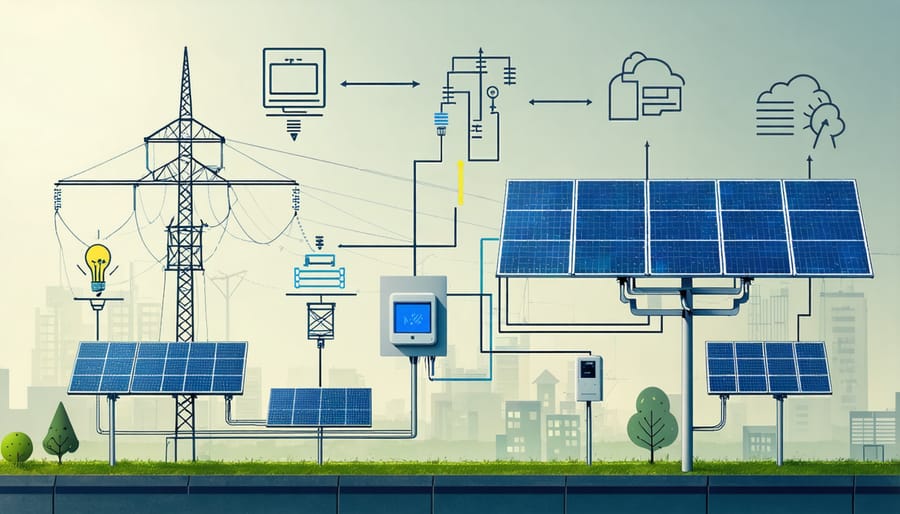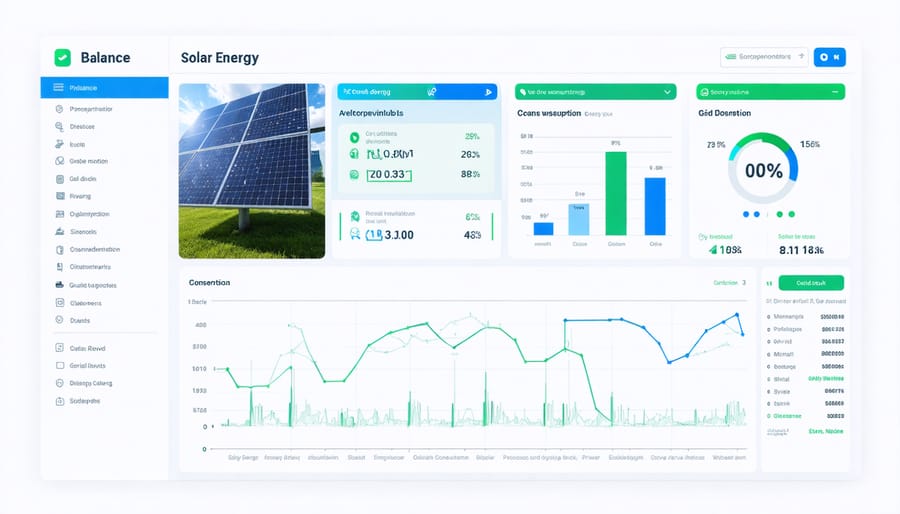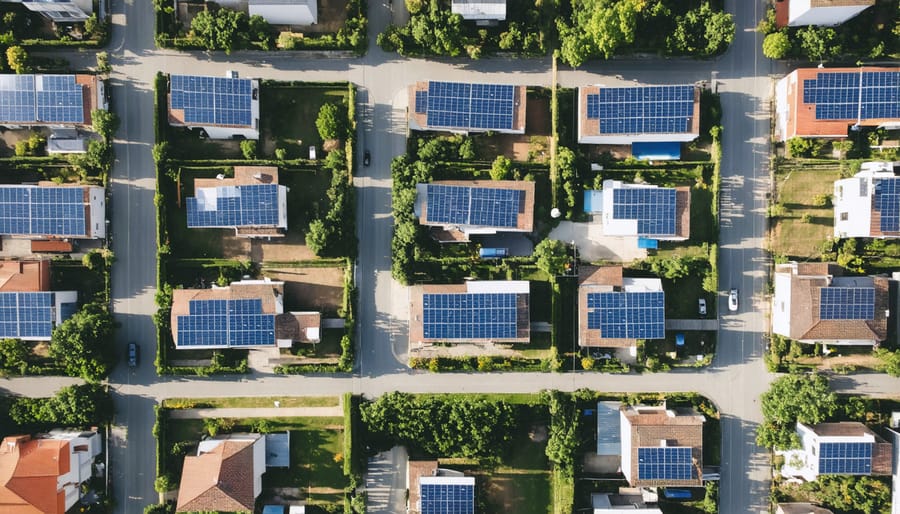Solar-Powered Smart Grids Are Revolutionizing European Energy Networks

The renewable energy smart grid represents a transformative leap in how we harness, distribute, and consume clean energy across Europe’s evolving power landscape. By integrating advanced digital communications, real-time monitoring, and automated control systems, smart grids are revolutionizing the relationship between energy producers and consumers. This sophisticated infrastructure enables bidirectional power flow, allowing solar panels, wind turbines, and other renewable sources to seamlessly feed into the grid while maintaining stable supply and optimal efficiency.
In today’s climate-conscious world, smart grids serve as the backbone of sustainable energy systems, effectively managing the intermittent nature of renewable sources through intelligent load balancing and energy storage solutions. For European businesses and homeowners, this technology offers unprecedented control over energy consumption, reduces operational costs, and contributes to carbon reduction goals. The system’s ability to predict demand patterns, respond to peak loads, and self-heal during disruptions ensures reliable power delivery while maximizing the use of clean energy resources.
As we advance toward a carbon-neutral future, smart grid technology stands as a crucial enabler of Europe’s energy transition, providing the intelligence and flexibility needed to support a fully renewable energy ecosystem.
The Evolution of Smart Grid Technology in Solar Power
Key Components of Solar Smart Grids
Smart grids rely on several interconnected components that work together to create an efficient and responsive energy distribution system. At the core are advanced metering infrastructure (AMI) sensors that continuously monitor power flow, voltage levels, and consumption patterns in real-time. These intelligent sensors enable precise measurement and instant data collection across the network.
Communication systems form the backbone of smart grid operations, utilising secure wireless and fibre-optic networks to transmit data between components. This robust infrastructure enables seamless information exchange between power generation facilities, storage systems, and end-users, ensuring optimal energy distribution and rapid response to demand changes.
Control mechanisms, including automated switches and smart inverters, manage power flow and maintain grid stability. These sophisticated devices can instantly react to fluctuations in solar power generation and consumption, preventing outages and maintaining consistent power quality. Energy management systems (EMS) integrate these components, using artificial intelligence and machine learning algorithms to optimise grid performance and efficiency.
Data analytics platforms process the vast amount of information collected, providing actionable insights for grid operators and consumers alike, while ensuring cybersecurity measures protect the entire network.

Real-Time Energy Management Systems
Real-time energy management systems are the backbone of modern smart grids, enabling efficient distribution and storage of solar power across the network. These sophisticated systems continuously monitor energy production, consumption patterns, and grid stability to optimize power flow and maintain reliable service.
Using advanced algorithms and AI-driven analytics, smart grids automatically adjust to changing conditions, such as sudden cloud cover affecting solar panel output or unexpected spikes in energy demand. The system can instantly redirect power from areas with excess generation to those experiencing higher demand, ensuring optimal resource utilization.
Storage management is another crucial function, where the system intelligently determines when to store surplus solar energy in batteries and when to release it back to the grid. This capability is particularly valuable during peak consumption hours or when solar generation is low, helping maintain grid stability and reducing reliance on conventional power sources.
For European households and businesses, this translates to more efficient energy use, lower costs, and enhanced grid reliability, supporting the continent’s transition to sustainable energy solutions.
Smart Grid Innovations Transforming Solar Energy
Advanced Metering Infrastructure
Advanced Metering Infrastructure (AMI) forms the backbone of modern solar energy management systems, enabling two-way communication between utilities and consumers. Smart meters, the cornerstone of AMI, provide real-time data about energy consumption and production, allowing for precise monitoring and control of solar power systems.
These sophisticated devices measure electricity flow in both directions, essential for solar installations where excess energy may be fed back into the grid. They record consumption in intervals as short as 15 minutes, providing granular insights into energy usage patterns and solar system performance. This detailed data helps homeowners and businesses optimise their energy consumption and maximise the benefits of their solar investments.
In the European context, smart meters are increasingly becoming standard equipment, driven by EU directives promoting energy efficiency and grid modernisation. They enable dynamic pricing models, where energy costs vary based on time-of-use, encouraging consumers to shift their consumption to periods of peak solar production.
The integration of smart meters with solar systems creates numerous advantages:
– Real-time monitoring of solar energy production
– Accurate billing for energy exported to the grid
– Automated fault detection and system diagnostics
– Enhanced energy consumption awareness
– Simplified integration with home energy management systems
This infrastructure is essential for the successful implementation of demand response programs and the efficient management of distributed solar resources across the power grid.

Automated Grid Balancing
Modern smart grids employ sophisticated artificial intelligence and automation systems to maintain grid stability and energy storage when managing variable renewable energy sources. These intelligent systems continuously monitor power generation, consumption patterns, and grid conditions in real-time, making split-second adjustments to ensure reliable power delivery.
The automation process begins with advanced forecasting algorithms that predict solar generation based on weather patterns, historical data, and satellite imagery. This predictive capability allows grid operators to anticipate fluctuations in solar power output and prepare appropriate responses hours in advance.
When solar production varies due to changing weather conditions, automated systems instantly activate various balancing mechanisms. These include adjusting energy storage systems, modifying demand response programs, and optimizing power flow across different grid sections. The AI-driven controllers can activate backup power sources or redirect excess energy to storage facilities within milliseconds.
European grid operators have implemented particularly sophisticated automated balancing systems, which have proven crucial in regions with high solar penetration rates. These systems use machine learning to improve their performance over time, analyzing vast amounts of data to optimize grid operations and minimize waste. The result is a more resilient and efficient grid that can accommodate increasing amounts of renewable energy while maintaining consistent power quality for consumers.

Benefits for European Communities
Enhanced Energy Efficiency
Smart grids revolutionize how we harness and distribute solar energy by implementing advanced monitoring and control systems. Through real-time data analysis and automated load management, these intelligent networks significantly reduce energy waste while optimizing power distribution across the grid. Studies from successful smart grid implementations show efficiency improvements of up to 15-20% compared to traditional systems.
The integration of smart meters and IoT sensors enables precise monitoring of energy consumption patterns, allowing the grid to anticipate and respond to demand fluctuations. During peak solar production hours, excess energy is automatically redirected to storage systems or areas of high demand, ensuring maximum utilization of renewable resources.
Advanced forecasting algorithms predict solar generation based on weather patterns and historical data, enabling proactive grid management. This predictive capability helps balance supply and demand more effectively, reducing the need for backup power systems and minimizing energy losses during transmission and distribution.
Smart grids also empower consumers to actively participate in energy management through mobile applications and home automation systems, providing real-time insights into consumption patterns and enabling informed decisions about energy usage.
Grid Reliability and Resilience
Smart grid technology has revolutionized the way we manage and distribute renewable energy, significantly enhancing system reliability and resilience. Through advanced monitoring systems and automated responses, modern grid reliability solutions can predict, prevent, and quickly respond to potential disruptions, ensuring consistent power delivery to European homes and businesses.
Real-time data analysis and smart sensors continuously monitor grid conditions, enabling immediate detection of voltage fluctuations, equipment failures, or overload situations. This proactive approach allows the system to automatically reroute power through alternative pathways, preventing widespread outages and maintaining service continuity.
The integration of artificial intelligence and machine learning algorithms further strengthens grid resilience by predicting potential issues before they occur. These systems analyze weather patterns, consumption trends, and equipment performance data to optimize power distribution and maintenance schedules.
During extreme weather events or unexpected surges in demand, smart grids can automatically implement load balancing and demand response measures. This capability, combined with distributed energy storage systems, creates multiple layers of redundancy, ensuring that critical infrastructure remains powered even during challenging conditions.
Implementation Strategies and Support
Planning and Assessment
Successful smart grid integration begins with a thorough assessment of existing infrastructure and energy requirements. The planning process typically involves four key phases: system evaluation, infrastructure analysis, stakeholder consultation, and implementation strategy development.
During the initial evaluation phase, energy consumption patterns and peak demand periods are carefully analyzed. This data forms the foundation for determining optimal renewable energy integration points and required grid modifications. Special attention is paid to local grid capabilities and potential bottlenecks that might affect system performance.
Infrastructure analysis examines the current power distribution network, identifying necessary upgrades for bidirectional power flow and advanced monitoring capabilities. This includes evaluating communication infrastructure requirements and cybersecurity measures essential for smart grid operations.
Stakeholder consultation brings together utility providers, local authorities, and end-users to align objectives and address concerns. This collaborative approach ensures the smart grid design meets both technical requirements and user needs while complying with regional regulations.
The implementation strategy outlines a staged approach to smart grid deployment, typically starting with pilot projects before full-scale rollout. This includes defining clear milestones, establishing monitoring protocols, and developing contingency plans. The strategy also incorporates flexibility for future expansion and technological updates, ensuring long-term sustainability of the smart grid system.
Regular reassessment and optimization plans should be integrated into the strategy, allowing for continuous improvement as technology evolves and energy needs change.
Professional Integration Services
Professional integration of smart grid solutions requires expert support throughout the entire implementation process. Leading renewable energy providers offer comprehensive services that begin with detailed site assessments and feasibility studies to determine the optimal smart grid configuration for each specific location.
Project planning teams work closely with clients to develop customised implementation strategies that align with both technical requirements and business objectives. This includes system design, equipment specification, and integration planning with existing infrastructure. The process typically involves advanced simulation and modeling to ensure optimal performance before physical installation begins.
During implementation, experienced technicians handle everything from hardware installation to software configuration. This includes setting up monitoring systems, communication networks, and control interfaces. Special attention is given to ensuring seamless integration with existing power systems while maintaining grid stability and reliability.
Post-installation support typically encompasses system monitoring, maintenance scheduling, and performance optimization. Many providers offer remote monitoring services, enabling real-time system oversight and rapid response to any operational issues. Regular performance reviews and system updates ensure the smart grid solution continues to deliver optimal results.
Training programs are also available to help facility managers and technical staff understand system operation and maintenance requirements. This knowledge transfer is crucial for long-term success and maximizing the benefits of smart grid technology.
Smart grids represent a transformative leap forward in renewable energy integration, particularly for solar power systems across Europe. By enabling bi-directional energy flow, real-time monitoring, and automated management, these intelligent networks are revolutionising how we harness and distribute solar energy. The impact is already visible in numerous European communities, where smart grid implementation has led to increased grid stability, reduced energy costs, and improved integration of solar power systems.
As we move towards a more sustainable future, the widespread adoption of smart grid technology will be crucial for maximising the potential of solar energy. European homeowners and businesses are uniquely positioned to benefit from this evolution, with potential energy savings of up to 20% and enhanced grid reliability during peak demand periods.
The time to act is now. Whether you’re a homeowner considering solar installation or a business looking to optimise your energy consumption, implementing smart grid technology alongside solar power systems offers immediate and long-term benefits. By embracing this innovation today, we can contribute to a more sustainable and efficient energy future while ensuring Europe remains at the forefront of renewable energy advancement.
Leave a Reply